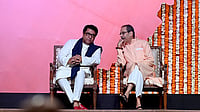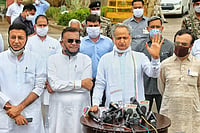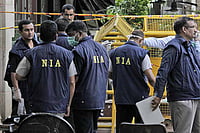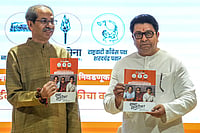Tucked away within the folds of Thar’s dunes, neither road nor electricity - nor any other marker of ‘progress’ - seems to have found their way to Chandan Singh ki Dhani. A dusty, drowsy desert hamlet in Rajasthan’s Jaisalmer district that has a handful of 18 families with grubby sheep and unkempt children living around a muddy well. An isolated, insular cluster of households lost to macro-sized maps and macro visions for development. But not to a newfound aspiration sweeping India’s vast hinterland, a yearning to see her children educated.
How do the fruits of literacy grow in this barren land? Listen to thirty-something Bhanwar Kanwar: "Only two women from the Dhani have travelled to Jaisalmer but then we are anpadh gadhe (illiterate donkeys). The next generation will see much more of the world, education will prepare them for it. That’s why I insist my nine-year-old daughter Dharmesh goes to school even if it’s a tedious seven km away." It helps that all the boys in the hamlet and eight girls join Dharmesh in her daily trek. Schooling, parents here have come to believe, gives them courage to face the world outside.
Thousands of miles away, in the lush sugarcane fields of Hosur in central Karnataka, this yearning for a better future finds an echo. Here, agricultural labourer Kichadi Jambiah, 40, states his determination to provide his son with an easier life while tilling a rich landlord’s land. Through that perceived passport to a golden future: education. "We are ready to face any hardship in life, we just want our son to become a doctor," says wife Lakshmavva. The father, meanwhile, monitors 13-year-old son Manjunatha’s class attendance with a hawk’s eye, no matter that the boy has to trudge a good six km to access his primary school in Chittavadgi town.
Only six years old, Sange Norbu too walks four km each day to get to school. But his Class X-pass mother Tshering Lamuh, a resident of Bomdir basti in Arunachal Pradesh’s Tawang district, thinks the distance nothing compared to the gulf education will bridge. "It’s far but worth it. We would, in fact, like Sange to go and study in Bomdilla, about 200 km away, and then even further. Education is better there and his life has to be...will be better than ours, we’re sure of that." That’s what Sasi and Chandrika feel. The couple sells dosas at a wayside stall at Thiruvananthapuram railway station and want better for their kids: "We couldn’t go to school, we want our children to get what we missed. That’s our main mission in life."
At the receiving end of a similar tenacious resolve, master Sangam Jadhav at Kapuswadi village’s primary school in Maharashtra’s Aurangabad district had a tough time during admissions last June. Unlike some years ago when he’d have to beg parental consent before literally dragging students into his classroom, last year he had to fight to keep underage children out. Also, the year ended with the district recording an astounding 93 per cent attendance in its primary schools. Master Jadhav is still reeling under the shock: "Something’s happened! Parents’ enthusiasm to somehow get their wards into class is overwhelming. People seem to have internalised the importance of education."
The writing on the blackboard is clear - there’s a huge groundswell in the demand for education. Cutting across states, it infects backward Rajasthan and Bihar as much as it does literate Kerala. The bad news: it’s a demand the government is barely able to cope with.
Parents, rich and poor, rural and urban, educated and illiterate, are today consumed by a desire, stronger than ever before, to see their children avail of education and almost as if by consequence, therefore, access better lifestyles. It’s an attitudinal change among parents really. A refrain earlier - "What good is education!" - is a rare response today. For the belief that education is benign, that it’s an essential ingredient for one’s well-being and most certainly for one’s upward mobility in the modern world seems to have permeated India’s collective consciousness. Hence, the growing clamour, the intense craving for education. More and better education.
Aspirational models beamed through airwaves to all nooks and crannies of the land, huge rural-urban migration and the constant feedback, the changing opportunity structure of villages - all contributed to the perception that literacy is a tool of rapid advancement. A tool that needs be acquired, for oneself and certainly for one’s children. Offering an interesting insight into this rush for letters, Prof Mohammed Talib, sociologist at the Jamia Millia University, says it is the ‘spectacle of development’ that’s moved the country’s poorest to aspire for education.
He elaborates: "The road connecting his village to the city, the Sumo that drives past his village - the poor villager has never travelled this path, never ridden this jeep. These are not the fruits of development that he has ever tasted, they are symbolic of a progress, a lifestyle that only the educated seem to have access to. Naturally, then, he wants his children educated so that they might partake these fruits of development that couldn’t be his."
This felt need at the ground level is much more real than sundry literacy statistics that quibble with each other to prove their own truths. Numbers that come from the UN pronouncing India the "most illiterate country in the world", against those that our National Survey touts, declaring us over 65 per cent literate. Does it matter really how literate or non-literate India is, considering the great upsurge in the longing to be lettered?
The PROBE (Public Report on Basic Education in India) survey conducted in over 200 villages in north India and released in 1999 had 80 per cent of the respondents saying primary education should be compulsory. Over 43 per cent said that they would like to see their offspring study as far as possible. An astounding 98 and 89 per cent said it was "important" for boys and girls to be educated, respectively (see graphics). That more daughters are being allowed to study than ever before, in fact, comes across through the responses recorded in yet another - and more recent - study conducted by the Delhi-based Centre for Advocacy and Research. Over 78 per cent of the parents interviewed from five districts in the states of Assam, Madhya Pradesh and Tamil Nadu say that "more girls are being educated" these days.
Significantly, though, the need of the day seems to be not just education but a certain standard in education. Not content merely with ensuring their children make it inside classrooms, people have expectations of what and how things should be taught in there. Says Bhopal-based Anjali Narona of Eklavya, an ngo involved in primary education for the past 20 years: "No longer is education perceived as a ‘bitter pill’. Willing to participate in the lessons of their children, communities are discovering that learning can be fun. That it can, and should, involve local language, festivals and surroundings."
Having studied till Class IX, Ramsiya of Shahpur village near Madhya Pradesh’s Jabalpur township expresses dissatisfaction with the lessons being taught in schools: "This education leaves you no good for work in the fields." Hardly surprising then that even as parents from rural and urban Uttarakhand expressed a keen desire to send their children to school, in a recent study conducted by Mussoorie-based ngo sidh (Society for Integrated Development of Himalayas) they harshly critiqued the education system for its defects. The system, many felt, alienated the child from their land. A typical parental observation from the report: "The rural-educated fits in the city and an urban-educated person fits in a foreign country."
It’s this alienating curriculum, the sheer irrelevance of the lessons being taught, that keeps many children out of schools and forces others to drop out, argues Prof Anil Sadgopal, head of the department of education in Delhi University (DU). After all, 70 of every 100 children in our country do enrol into Class I, something must be happening there for more than half of them to opt out before they finish primary school.
Says Sadgopal: "What good is the growing demand for education considering the past 50 years have seen no attempts being made to change the character of the education being offered? Memory rather than creativity, information rather than skill is being taught. The government provides a facility rather than functioning schools; broken roofs, no toilets, dingy environs. So it’s understandable that parents see no reason to send their children to these classrooms, which, in turn, has the government spending crores in campaigns trying to enthuse people into sending their wards to school!"
Or, setting up parallel streams of education to meet the rising demand mainstream schools can’t seem to cope with. Like the over 2.5 lakh Non-Formal Education (nfe) centres. Meant for the poorest in the country, these centres are intended to be set up at locales and timings convenient to the children, employ local teachers familiar with the students’ mother tongue and have flexible and relevant curricula. Laudable intentions that might well have been engaged in mainstream schools. But then, that would have meant political commitment to make mainstream sarkari schools work, instead of dumping it for alternate arrangements to somehow letter India.
Not that the NFES - with abysmal pass percentages - have achieved much other than setting up a caste system in education. The rich elite would never send their children to one of these informal sarkari arrangements, just as they wouldn’t to a formal sarkari school. Actually, if the poor could afford it, they wouldn’t either.
Like Mumbai housemaid Ranjana Shinde, who hopes to be able to send her nine-year-old son Kiran to an English-medium school. Not too happy with the quality of instruction in Adarsh Nagar Government School where he presently studies, she shells out an extra Rs 200 from her paltry Rs 2,000 monthly income towards private tuitions for him. "The only reason I mop floors and wash clothes in other people’s houses is to be able to educate my son. If I could only afford to put him in an English-medium school..."
A hankering fed by the fact that the state’s schools don’t match her expectations as institutions fit for her child. Her demand for quality education, unfulfilled by the government, finds other suppliers. Suppliers who frequently promise her much more than they ever deliver. They call themselves ‘public schools’, are mostly ‘English-medium’, and mushroom in our larger villages, small towns and big cities. More often than not, they are unrecognised, and subscribe to no norms at all: just have the whim, have a spare room, rope in someone barely literate as a teacher and start up a study shop.
Like the one in north Delhi’s downmarket Nirankari Colony, where a beauty parlour owner employs her beauticians (post their hair-cutting assignments) to teach 45 children in the one-room school she runs. These ‘teachers’ are paid Rs 400 for working in school and Rs 800 for their skill as beauticians. And confess that they are neither qualified nor interested in playing Madam: "But the money comes in handy." The school’s anglicised name, Little Angel Public School, however, is attractive enough for it to get away with charging Rs 75 monthly per student.
Generally, up to Class V, students who pass out from such schools have little option but to get into similar, though ‘recognised’, privately-run ‘public’ schools where the fee is considerably higher. Many can’t afford it. And most of them, ill-taught as they are, find themselves being turned down everywhere but in government schools. Thus bringing down the government school results even further.
But despite their flaws, there’s no denying that somewhere these private schools cater to a market that wants better than the services the government delivers. But having conceded this, the rapid rise of the private sector in education has more worrisome fallouts than just the suspect quality of lessons being taught. "The filter effect is that these schools are widening the gap between the rich and poor, the son and daughter," says Prof Krishna Kumar of DU’s Department Education. Many families, even middle-class ones, send the son to a private school while the old sarkari pathshala is deemed fit for the daughter. Similarly, the elite, the more vociferous and affluent section of society is gradually severing all ties with government schools.
Little wonder then that with the stronger and privileged out and the weaker and discriminated within its dingy classrooms, government schools seem poised to slide further down the quality ladder.
A mere 50-km ride through Rajasthan’s Barmer district - which has one of the country’s lowest literacy rates - reveals at least three primary schools that shame India’s education system. The first, in Jasotoniyon ki Dhani, is locked and has hordes of children horsing around as both their teachers haven’t come in for five days. The second, in Agoriya, has a bunch of disinterested kids staring at some illegible scrawl on a graying blackboard; their missing teacher, one Shaitan Singh, is finally called from the nearby paan shop and begs his absence not be reported to the authorities. The third, the Rajiv Gandhi Golden Jubilee Pathshala in Sidhiyoni ki Dhani, is run from a grass hut and has master Bhakar Singh cribbing of not having received his salary for the past seven months: "The panchayat set up this school under some government scheme. Now they bully me and don’t pay." Frustrated and planning to return to his original vocation as a taxi-driver in Jaipur, the Class VIII-pass Singh would have loved to teach. Says he wistfully, "Look how clean they are. They never were so clean before they started school. Education changes your appearance!"
This, the common man’s new-found faith in the magic of education, seems India’s greatest hope. Undeterred by the fact that the supply far outstrips demand for education, both in quantity and quality terms, citizens are joining hands to provide themselves with the education they need. Ordinary people, ngos, women’s organisations, charitable trusts, religious missions and even corporate houses do their bit to educate India.
In Bihar, the government’s educational infrastructure is expectedly in disarray. Yet, two heartening tales give us reason to believe that citizens’ initiatives create happy classrooms in the gloomiest of environs. A concerned Indian, Rekha Khanna’s efforts have given 200 tribal children the opportunity to sing and play in a classroom. With the nearest government school eight km from his village Latardih in Jamshedpur district, a man like Lalmuni Munda could not have enjoyed dropping his daughter to school but for Khanna’s efforts. Other happy stories, meanwhile, come from the 10,000 students in and around Jamshedpur who benefit from the Tatas’ active efforts to better education. Also, the company’s concern for tribals has seen it opening and supporting educational institutions in the remotest deep-forest areas in the district. Yes, many are chipping in. Because there are many who want to be, need to be educated. India’s children won’t be kept out of classrooms any more. And the government had better cope with the learning rush.


























